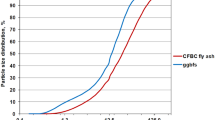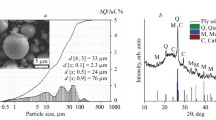Abstract
The hydration processes of mixtures containing calcined gypsum, blastfurnace slag or fly ash, portland cement and/or hydrated lime, able to generate calcium trisulphoaluminate and silicate hydrates, have been studied by means of differential thermal analysis. Samples were aged at 55°,70° and 85°C for 16, 24 and 48 hours, followed by a further curing at room temperature and humidity up to 28 days.
In the case of the systems containing slag, the optimum pre-curing temperature is 55°C and increasing the pre-curing time from 16 to 48 hours leaves the hydration degree almost unchanged.
In the case of the systems containing fly ash the optimum pre-curing temperature is 85°C. Increasing the pre-curing time from 16 to 24 hours enhances the hydration degree. The further increase to 48 hours reduces the selectivity towards calcium trisulphoaluminate hydrate.
In all the systems investigated the post-curing at room temperature and humidity has no significant effect on the hydration degree.
Finally, the influence of the nature of raw materials depends not only on the characteristics of each component, but also on those of the others.
Zusammenfassung
Mittels DTA wurden die Hydratationsprozesse von Gemischen aus Gips, Hochofenschlacke oder Flugasche, Portlandzement und/oder Löschkalk untersucht, die zur Bildung von Calciumtrisulfoaluminat und Silikathydraten fähig sind. Die Proben wurden bei 55°, 70° und 85°C für 16, 24 und 48 Stunden lang, im Anschluß daran durch Aushärten bei Raumtemperatur und normaler Luftfeuchte 28 Tage lang gealtert.
Bei der Verwendung von Schlacke beträgt die optimale Vorhärtungstemperatur 55°C und die Erhöhung der Vorhärtungsperiode von 16 auf 48 Stunden ließ den Hydratationsgrad unverändert.
Bei der Verwendung von Flugasche beträgt die optimale Vorhärtungstemperatur 85°C. Die Erhöhung der Vorhärtungsperiode von 16 auf 14 Stunden steigert auch den Hydratationsgrad. Eine weitere Steigerung auf 48 Stunden setzt die Selektivität gegenüber Calciumtrisulfoaluminat-Hydrat herab.
In keinem der untersuchten Systeme hatte das Nachhärten bei Raumtemperatur und normaler Luftfeuchte einen signifikanten Einfluß auf den Hydratationsgrad.
Letztendlich hängt der Einfluß der Ausgangsmaterialien nicht nur von den Eigenschaften jeder einzelnen Komponente, sondern auch von denen der anderen Komponenten ab.
Similar content being viewed by others
References
T. Azuma and K. Ichimaru, Japan Kokai, 76 (1976) 826.
T. Azuma, K. Ichimaru, T. Murakami and K. Tateno, Ger. Offen, 2 (1976) 310.
P. K. Mehta, World Cement Technology, 11 (1980) 166.
J. Beretka, L. Santoro and G. L. Valenti, Proc. 4th Int. Conf. on Durability of Building Materials and Components, Singapore Pergamon Press, 1987, p. 64.
J. Beretka, G. L. Valenti, L. Santoro and R. Cioffi, Int. Patent Appl. No. PCT/AU87/00Y19, 1987.
G. L. Valenti, L. Santoro and G. Volpicelli, Thermochim. Acta, 78 (1984) 101.
L. Santoro, I. Aletta and G. L. Valenti, Thermochim. Acta, 98 (1986) 71.
J. Beretka, R. Cioffi, L. Santoro and G. L. Valenti, Proc. 3rd Int. Symp. on Phosphogypsum, Pergamon Press, Orlando 1990, p. 417.
V. S. Ramachandran, Application of DTA in cement chemistry, Chem. Publ. Co. Inc., New York 1969.
M. Murat, Proc. Int. Semin. Calcium Aluminates, Torino 1982, p. 59.
Author information
Authors and Affiliations
Rights and permissions
About this article
Cite this article
Cioffi, R., Marroccoli, M., Santoro, L. et al. DTA study of the hydration of systems of interest in the field of building materials manufacture. Journal of Thermal Analysis 38, 761–770 (1992). https://doi.org/10.1007/BF01979406
Issue Date:
DOI: https://doi.org/10.1007/BF01979406




